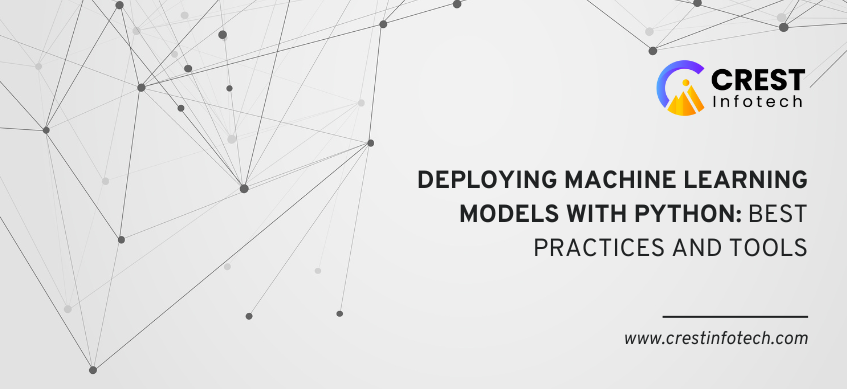Machine learning (ML) has revolutionized numerous industries, from healthcare to finance, by providing predictive insights and automation. However, building a model is just the first step; deploying it effectively into production is where the real value lies. In this article, we will explore the best practices and tools for deploying machine learning models with Python, ensuring that your models are efficient, scalable, and maintainable.
1. Preparing the Model for Deployment
Before deploying a machine learning model, it’s important to follow a few key steps to ensure the model is production-ready:
Model Evaluation
Ensure that the model is well-trained and thoroughly evaluated before deployment. This includes:
- Cross-validation: This ensures the model’s generalizability.
- Hyperparameter tuning: Optimize the model for better performance.
- Model performance tracking: Measure metrics such as accuracy, precision, recall, F1-score, or any specific metric relevant to the problem.
Versioning the Model
It’s crucial to keep track of different versions of the model. This allows you to compare performance across different versions and ensures you can roll back to a previous version if needed.
You can version your models using tools like:
- MLflow: An open-source platform that manages the lifecycle of ML models.
- DVC (Data Version Control): A Git extension for managing machine learning projects, including datasets and model versions.
2. Choosing a Deployment Strategy
There are several deployment strategies available, each suited to different use cases. The choice of strategy depends on factors such as the scale of the application, the frequency of model updates, and real-time inference needs.
Batch vs. Real-time Inference
- Batch Inference is suitable when the model does not need to generate predictions in real-time. Predictions are made on a batch of data at scheduled intervals. This is common in applications where predictions are used for reports or analyses.
- Real-time Inference involves making predictions instantly as new data arrives. This is crucial for applications like recommendation systems or fraud detection, where immediate responses are required.
Model Hosting Options
Models can be hosted in several ways:
- On-premise (self-hosted) servers: Suitable for organizations that require full control over the infrastructure.
- Cloud services: Platforms like AWS, Google Cloud, and Microsoft Azure offer managed machine learning services that simplify deployment. They provide automated scaling, version control, and monitoring.
3. Deployment Tools and Frameworks
Python offers several tools and frameworks that streamline the process of deploying machine learning models.
Flask/Django for REST APIs
Flask and Django are Python web frameworks that can be used to serve your ML model as an API.
- Flask is lightweight and easy to use, perfect for small projects or quick deployments.
- Django is a more robust framework suitable for larger applications with many features.
You can create an API endpoint that accepts inputs from users and returns predictions from your model.
Example with Flask:
from flask import Flask, request, jsonify
import pickle
app = Flask(__name__)
model = pickle.load(open('model.pkl', 'rb'))
@app.route('/predict', methods=['POST'])
def predict():
data = request.get_json()
# Get data from the request
prediction = model.predict([data['features']])
return jsonify({'prediction': prediction.tolist()})
if __name__ == '__main__':
app.run(debug=True)
FastAPI for High Performance
FastAPI is a modern Python web framework designed for fast API creation. It is particularly useful when dealing with high-load environments and real-time inference due to its asynchronous capabilities.
TensorFlow Serving and TorchServe
For deep learning models, TensorFlow Serving and TorchServe provide optimized serving solutions for TensorFlow and PyTorch models, respectively.
- TensorFlow Serving: A system for serving TensorFlow models with features like batching, multi-threading, and version management.
- TorchServe: Developed by AWS and Facebook, TorchServe is designed for PyTorch models, providing similar capabilities.
4. Containerization and Orchestration
To ensure that your model is portable, scalable, and easy to deploy across different environments, you can use containerization and orchestration.
Docker
Docker allows you to containerize your ML model and its dependencies into a single image. This ensures consistency across different environments and makes the deployment process easier.
Example of creating a Docker container for a Flask API:
# Create a Dockerfile
FROM python:3.8-slim
WORKDIR /app
COPY . .
RUN pip install -r requirements.txt
CMD ["python", "app.py"]
# Build the Docker image
docker build -t my_model_api .
# Run the Docker container
docker run -p 5000:5000 my_model_api
Kubernetes
Kubernetes is a container orchestration tool that can be used to manage the deployment, scaling, and operation of containerized applications. If you’re deploying multiple instances of your ML model, Kubernetes can automatically scale the number of pods (containers) based on demand.
5. Model Monitoring and Logging
Once deployed, monitoring is essential to ensure your model continues to perform as expected. Key aspects to monitor include:
- Model drift: Over time, a model may degrade in performance due to changes in the data distribution. Regularly monitor performance metrics and retrain the model if necessary.
- System health: Track the performance of the underlying infrastructure, such as latency, throughput, and error rates.
Tools like Prometheus (for metrics collection) and Grafana (for visualization) are commonly used to monitor deployed models.
Logging and Error Handling
Logging is important for tracking requests, responses, and errors. Python’s built-in logging module can be used to log important events.
import logging
@app.route('/predict', methods=['POST'])
def predict():
try:
data = request.get_json()
prediction = model.predict([data['features']])
logging.info(f"Prediction successful: {prediction}")
return jsonify({'prediction': prediction.tolist()})
except Exception as e:
logging.error(f"Error in prediction: {e}")
return jsonify({'error': 'Prediction failed'}), 500
6. CI/CD for Machine Learning Models
Continuous Integration and Continuous Deployment (CI/CD) pipelines are key to ensuring the efficiency and automation of the deployment process. For ML models, CI/CD pipelines can automate testing, model training, evaluation, and deployment.
- GitLab CI/CD: Automate testing and deployment pipelines for your ML models.
- Jenkins: Can be used for orchestrating workflows to automate model training and deployment.
- CircleCI: Another popular CI/CD tool for automating the machine learning workflow.
Conclusion
Deploying machine learning models requires careful preparation, effective strategies, and the right tools to ensure scalability and maintainability. By evaluating and versioning models, selecting an appropriate deployment strategy, using containerization, and setting up CI/CD pipelines, you can streamline the process and ensure your models are production-ready. Whether you’re using Flask, FastAPI, or specialized tools like TensorFlow Serving or Docker, the right deployment strategy and tools will enable you to deliver high-quality, reliable machine learning solutions at scale.



